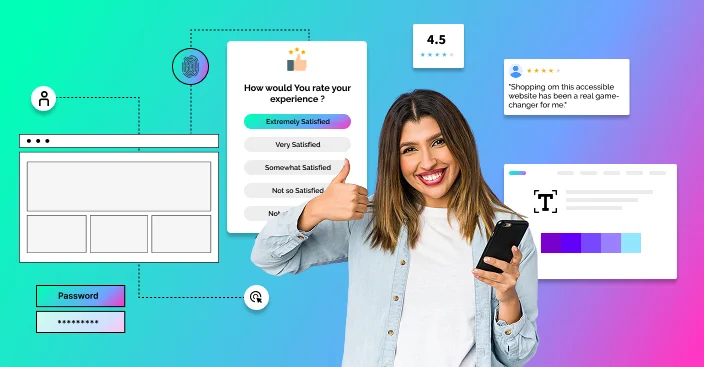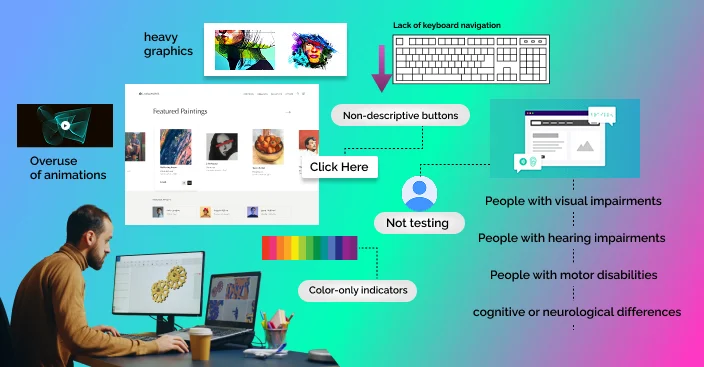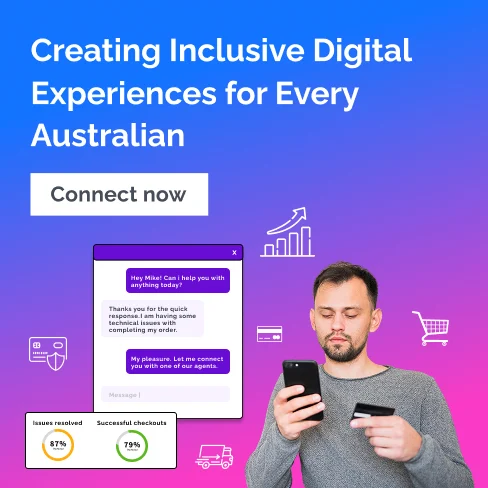Better User Experience (UX) in 2025: The Need for Inclusivity and Accessibility in Australian Web Design

Accessibility by 2025 has now ceased to be a desire but a necessity for Australian web development. With growing digital reliance and shifting user demands, organisations need to ensure their digital experiences are accessible so that they can connect with users of all capabilities.
Pressure for accessible digital experiences is brought about along with developments in the WCAG 2.2 guidelines, human-centric innovation, and extrinsic pressure from legal and ethical sides.
Inclusive design has now crossed the borders of disability into aging communities, neurodiverse customers, and multilingual societies.
Australian developers and designers are focusing on UX measures that not only adhere to the legislation but also increase trust in the brand, user interaction, and overall conversion rate.
Top Most Significant Trends in Australian Web Design in 2025
AI-Driven Personalisation for People with Disabilities
Systems powered by AI are transforming the user interface by tailoring websites to users’ individual accessibility needs. With d ynamic interfaces, for example, modify text size, contrast ratio, and navigation controls in response to user activities.
These functions make it easier for visually and cognitively disabled individuals to access web content. eCommerce leaders in Australia are embracing these technologies to provide a seamless online purchasing experience, resulting in reduced cart abandonment and increased retention.
With AI gaining strength in being able to help and enhance the life of humankind in a positive way, its potential to create inclusive and personalised web experiences also stands to expand much more across healthcare, education, and retail sectors.
Voice Search and Speech Recognition
With voice devices and intelligent assistants becoming increasingly popular, Australian websites are speech recognition-optimised and voice command-enabled.
Besides being functional, it offers mobility for the vision-impaired.. Service providers and vendors are simplifying backend schema to facilitate natural language questioning for search engine optimisation as well as accessibility.
Multilingual as well as context-savvy, voice technology would be best suited for the Australian community so that various types of users will be left with the same digital experiences.
Responsive and Device-Agnostic Design
One can anticipate a frictionless experience on those devices of use in Australia-being worked on desktops, tablets, mobile phones, or assistive technologies by 2025.
For responsive design, the attention diverts from minimalistic screen sizes to the adaptation of content to screen readers, Braille displays, and alternate means of input. This trend provides equal access to all users, irrespective of capability or device.
Developers now incorporate accessibility testing across device groups during design time using sophisticated tools and simulators. Mobile-first accessibility is taking hold, and companies across industries such as finance, travel, and real estate are adopting responsive inclusivity in order to engage more people.
Inclusive UX Writing and Multilingual Accessibility
Words bring experiences to life, and inclusive websites in 2025 take pride in accessible language. Australian businesses are employing UX writers with accessibility training best practices so that instructions and labels are correct, concise, and readable – even to non-native speakers or cognitively impaired users.
Additionally, multilingual support is expanding due to multicultural communities in Australia. Businesses are offering translated versions with accurate cultural localisation and tags of accessibility as well.
Captions, ARIA labels, and alt-text are all intended to be easily readable and educational. This change promotes understanding, builds trust, and guarantees that everyone may access online places.

Gen Z’s Impact on Web Design Accessibility
Generation Z, generated in an entirely digitally native world, is dramatically shaping the Australian web-accessibility conversation. This socially aware collective cares about inclusivity, diversity, and socially responsible design.
Their vast online presence, coupled with an innate need for hassle-free online experiences, compels brands toward universal access. Gen Z, at an interaction level, requires more engagement than function. On very minimal designs, dark mode, and keyboard navigation lies the strong force of Gen Z influence.
Gen Z developers and designers entering the workforce with an innovation mindset are starting to factor in the WCAG principles right at zero instead of after the fact and would be right. They expect accessibility in hackathons, design sprints, and community projects, defining new norms for the industry.
Their impact is pushing the accessible design attractive to businesses to comply not only with compliance but as an organisational principle, so that there is a future where digital culture is inclusive from day one.
ROI of Accessibility for Australian Businesses
Accessible UX investment isn’t just the right thing to do—it’s lucrative. Australian companies adopting accessible web design are experiencing greater customer satisfaction, lower bounce rates, and better conversion rates.
Accessibility makes your brand accessible to more customers, including disabled consumers and aging populations. Accessibility enhances SEO, lowers legal risk, and enhances usability across the board.
Government sites and top Australian retailers have experienced greater engagement and lower maintenance costs following WCAG 2.2 compliance.
Accessibility also adds to brand trust, an important commodity in competitive market places. In the last sense, accessible design inevitably leads to better business performance and long-term sustainability.
Future-Forward Technologies Enabling Accessibility
AI Accessibility Engines
AI accessibility engines monitor user activity and dynamically modify web components such as font size, color difference, or navigation in real time.
These systems automatically adapt based on user feedback and dynamically adjust the interface according to users with visual and cognitive impairments. Increasingly, Australian eCommerce websites are adding these engines to eliminate friction and drive conversions.

AR/VR for Accessible Experiences
Augmented and Virtual Reality is also available to be utilised, with guided shopping, orientation assistance, or simulation training.
Voice command, haptic feedback, and assistive device support make these virtual environments accessible to users with all categories of disability, redefining inclusion.
Accessibility Testing Automation Tools
Modern Australian developers employ automation tools like axe-core, Wave, and Google Lighthouse to execute accessibility testing. It identifies issues in real-time so worthy of WCAG 2.2 compliance from day one and a longer time-to-market with reduced post-launch repair.
Edge Computing & Speed Optimisation
Fast-to-load, low-latency websites are central to accessible UX. Edge computing reduces data processing latency by pushing it closer to the user, which makes the site load faster for users with poor connectivity or slower assistive devices—something rural Australia is in dire need of.
Best Accessible Web Design Practices in 2025
Adhering to WCAG 2.2 Guidelines
Sites should always be updated to meet the most recent WCAG criteria in order to remain accessible to all users. Focus especially on screen reading connectivity, keyboard navigation, and colour contrast.
ARIA & Semantic HTML Labels
Organise your content in a correct manner using correct HTML tags and ARIA attributes so that it is screen reader-readable and assistive technology-readable.
Make It Accessible on Mobile
Plan for touch targets, voice control, and readable text to assist disabled mobile users. Test on various screen sizes and devices.
Offer Text Alternatives
Apply clean captions, video transcripts, and alt-text for images. This makes it an easy process for visually and hearing-impaired users’ access to the content.
Test with Real Users
Usability testing with disabled people. Their input identifies issues real-world usage may uncover, which automated testing may overlook, and guarantees real-world accessibility.
Government Support and Industry in Australia
The Australian government encourages digital accessibility by actively promoting it through the Digital Service Standard and support of WCAG 2.2.
The government websites have to support the standards, and thus become a model for the private industries.
Funding and training initiatives exist to assist small businesses in making their sites accessible. And advocacy and support are offered by industry bodies such as the Australian Network on Disability (AND) and Centre for Inclusive Design (CFID).
Accessibility is turning into corporate social responsibility (CSR), with major Australian corporates making public commitments to inclusive digital practice.
Conclusion
Accessible UX in 2025 isn’t merely about compliance following through – it’s about designing for large, usable, and equitable digital experiences.
In Australia, the digital shift is happening at a rapid rate, with the government-backed standards for AI-driven customisation.
Brands that make accessibility investments gain from increased brand recognition, a competitive edge, and a higher return on investment.
Gen Z values, rapid technology, and the regulatory environment are colliding to put accessibility front and centre in modern web design.
Connect with our web design experts for a better outcome for user engagement. Ensure higher conversion and overall success for the Australian brand.
FAQs
 Why is WCAG 2.2 useful for Australian brands?
Why is WCAG 2.2 useful for Australian brands?
WCAG 2.2 helps to boost web experience for Australian users, from meeting customer demands and law it helps to offer the best experience to the end-customers by meeting the regulatory standard.
 What are the most important accessibility trends for Australian eCommerce websites in 2025?
What are the most important accessibility trends for Australian eCommerce websites in 2025?
The most important of these trends is voice search functionality, dark mode functionality, screen reader functionality, accessible product descriptions, and navigation by keyboard alone—all to make eCommerce accessible to all.
 Is there business ROI in Australia in creating accessible UX?
Is there business ROI in Australia in creating accessible UX?
Accessible websites help with SEO rankings, reach more customers, convert more users; and avoid legal risks. In 2025, it shall be a strategic investment for long-term brand building.
 Voice Search Optimisation in Assistive Site Creation?
Voice Search Optimisation in Assistive Site Creation?
Voice search enables users with motor or vision impairments to easily use sites. Voice search also enhances UX more generally for multitask and mobile users and facilitates more accessible and enjoyable content.
 How is Australian web design accessibility being shaped by Gen Z?
How is Australian web design accessibility being shaped by Gen Z?
Gen Z loves inclusiveness, openness, and mental wellness. Their power urges companies to embrace inclusive design principles like clean UI, legible typography, closed captions, and mobile-first design.





